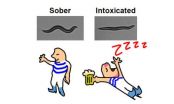(Press-News.org) Research from the University of Copenhagen is shedding new light on the brain's complicated barrier tissue. The blood-brain barrier is an effective barrier which protects the brain, but which at the same time makes it difficult to treat diseases such as Alzheimer's. In an in vitro blood-brain barrier, researchers can recreate the brain's transport processes for the benefit of the development of new pharmaceuticals for the brain. The new research findings are published in the AAPS Journal.
Ninety-five per cent of all tested pharmacological agents for treating brain disorders fail, because they cannot cross the blood-brain barrier. It is therefore important to find a possible method for transporting drugs past the brain's efficient outpost and fervent protector.
Researchers at the Department of Pharmacy at the University of Copenhagen have recreated the complex blood-brain barrier in a laboratory model, which is based on cells from animals. In a new study, the researchers have studied the obstreperous bouncer proteins in the barrier tissue. The proteins protect the brain, but also prevent the treatment of brain diseases:
"The blood-brain barrier is chemically tight because the cells contain transporter proteins which make sure that substances entering the cells are thrown straight back out into the bloodstream again. We have shown that the barrier which we have created in the laboratory contains the same bouncer proteins – and that they behave in the same way as in a 'real' brain. This is important, because the model can be used to test drive the difficult way into the brain. Complex phenomena – which we have so far only been able to study in live animals –can now be investigated in simple laboratory experiments using cultivated cells," says postdoc Hans Christian Cederberg Helms from the Department of Pharmacy.
The research team has shown that the transporter proteins P-glycoprotein, breast cancer resistance protein and multidrug resistance-associated protein 1 are active in the artificially created barrier tissue. The proteins pump pharmacological agents from the 'brain side' to the 'blood side' in the same way as in the human blood-brain barrier.
Collaboration finds a way
The new findings have resulted from collaboration with industrial scientists from the pharmaceutical company H. Lundbeck A/S.
"It is important to the treatment of brain diseases such as Alzheimer's that we find a way of circumventing the brain's effective defence. The university and industry must work together to overcome the fundamental challenges inherent in developing pharmaceuticals for the future," says Lassina Badolo, Principal Scientist with H. Lundbeck A/S and an expert on the absorption of medicines in the body.
Associate Professor Birger Brodin adds:
"We have shown that the models have the same bouncer proteins as the ones found in the intact barrier. We are now in the process of studying the proteins in the blood-brain barrier that accept pharmacological agents instead of throwing them out. If we can combine a beneficial substance which the brain needs with a so-called 'absorber protein', we will in the long term be able to smuggle pharmacological agents across the blood-brain barrier."
INFORMATION:
Birger Brodin heads the Drug Transporters in ADME research group which is responsible for the in vitro blood-brain barrier.
Birger Brodin
Cell: +45 22 48 03 55
The blood-brain barrier consists of a three-dimensional structure of blood vessels and support tissue, which sit close together.
The barrier is thus physically tight, but also chemically tight, because the cells contain transporter proteins which make sure that substances entering the cells are immediately thrown out into the blood again.
This is a problem when you are trying to design pharmacological agents acting on the central nervous system. Researchers therefore need a deeper understanding of the barrier properties.
New knowledge about the brain's effective bouncer
2014-07-16
ELSE PRESS RELEASES FROM THIS DATE:
Marijuana dependence alters the brain's response to drug paraphernalia
2014-07-16
New research from The University of Texas at Dallas demonstrates that drug paraphernalia triggers the reward areas of the brain differently in dependent and non-dependent marijuana users.
The study, published July 1 in Drug and Alcohol Dependence, demonstrated that different areas of the brain activated when dependent and non-dependent users were exposed to drug-related cues.
The 2012 National Survey on Drug Use and Health shows marijuana is the most widely used illicit drug in the United States. According to a 2013 survey from the Pew Research Center, 48 percent of ...
Dodos and spotted green pigeons are descendants of an island hopping bird
2014-07-16
The mysterious spotted green pigeon (Caloenas maculata) was a relative of the dodo, according to scientists who have examined its genetic make-up. The authors say their results, published in the open access journal BMC Evolutionary Biology, support a theory that both birds are descended from 'island hopping' ancestors.
The only known example of the spotted green pigeon is the Liverpool pigeon, which is currently in the World Museum, Liverpool. The only other known specimen has been lost, and there are no records of the bird in the wild. There is no record of where the ...
Patients at highest risk of suicide in first 2 weeks after leaving hospital
2014-07-16
Mental health patients are at their highest risk of dying by suicide in the first two weeks after leaving hospital - a report out today shows.
Around 3,225 patients died by suicide in the UK within the first three months of their discharge from hospital – 18% of all patient suicides, between 2002-2012.
The University of Manchester's National Confidential Inquiry into Suicide and Homicide by People with Mental Illness found that 526 patients died within the first week, the peak time of risk in England, Northern Ireland and Scotland; it is the first two weeks in Wales. ...
Underlying cause of cerebral palsy could lie in family links
2014-07-16
This is the first study to investigate cerebral palsy over such a broad range of family relationships.
Cerebral palsy is the most common cause of physical disability in children, affecting approximately two in 1,000 live births in the developed world (and many more elsewhere). It originates from damage to the 'immature' brain and several risk factors in pregnancy have been identified such as preterm delivery, abnormal growth, exposure to infection and lack of oxygen at birth.
Previous studies have found a possible family link with cerebral palsy, but positive findings ...
Is it time to lock up those who commit research fraud?
2014-07-16
Dr Zulfiqar Bhutta, Robert Harding Chair in global child health and policy and Co-Director of the Centre for Global Child Health at the Hospital for Sick Children, Toronto believes that criminal sanctions are necessary to deter growing research misconduct.
He says the fact that research fraud is common is no longer news, but a review by PubMed in 2012 found that 67% of research article retractions were "attributable to scientific misconduct, including fraud or suspected fraud".
Dr Bhutta says the consequences of research fraud on human health can be "huge" and that ...
Mutation stops worms from getting drunk
2014-07-16
Neuroscientists at The University of Texas at Austin have generated mutant worms that do not get intoxicated by alcohol, a result that could lead to new drugs to treat the symptoms of people going through alcohol withdrawal.
The scientists accomplished this feat by inserting a modified human alcohol target into the worms, as reported this week in The Journal of Neuroscience.
"This is the first example of altering a human alcohol target to prevent intoxication in an animal," says corresponding author, Jon Pierce-Shimomura, assistant professor in the university's College ...
Rainwater discovered at new depths
2014-07-16
University of Southampton researchers have found that rainwater can penetrate below the Earth's fractured upper crust, which could have major implications for our understanding of earthquakes and the generation of valuable mineral deposits.
It had been thought that surface water could not penetrate the ductile crust - where temperatures of more than 300°C and high pressures cause rocks to flex and flow rather than fracture - but researchers, led by Southampton's Dr Catriona Menzies, have now found fluids derived from rainwater at these levels.
Fluids in the Earth's crust ...
Transplantation of new brain cells reverses memory loss in Alzheimer's disease model
2014-07-16
SAN FRANCISCO, CA—A new study from the Gladstone Institutes has revealed a way to alleviate the learning and memory deficits caused by apoE4, the most important genetic risk factor for Alzheimer's disease, improving cognition to normal levels in aged mice.
In the study, which was conducted in collaboration with researchers at UC San Francisco and published today in the Journal of Neuroscience, scientists transplanted inhibitory neuron progenitors—early-stage brain cells that have the capacity to develop into mature inhibitory neurons—into two mouse models of Alzheimer's ...
JAMA study: Stroke risk and death rates fall over past 2 decades
2014-07-15
Fewer Americans are having strokes and those who do have a lower risk of dying from them finds a new study led by Johns Hopkins Bloomberg School of Public Health researchers.
The study found a 24 percent overall decline in first-time strokes in each of the last two decades and a 20 percent overall drop per decade in deaths after stroke. However, the decline in stroke risk was concentrated mainly in the over-65 set, with little progress in reducing the risk of strokes among young people. In contrast, the drop in stroke-related deaths each decade was primarily found among ...
Physicians struggle to clinically diagnose early HIV infection
2014-07-15
Despite the belief that early HIV infection presents with a well recognized flu-like syndrome, most physicians are unable to use clinical skills to differentiate those who should and should not be tested for HIV infection, according to a study published July 15 in Journal of the American Medical Association (JAMA).
Researchers at the BC Centre for Excellence in HIV/AIDS and University of British Columbia, Oregon Health and Science University, and Duke University Medical Centre analyzed data from over 24,000 patients, and discovered physicians have great difficulty recognizing ...


